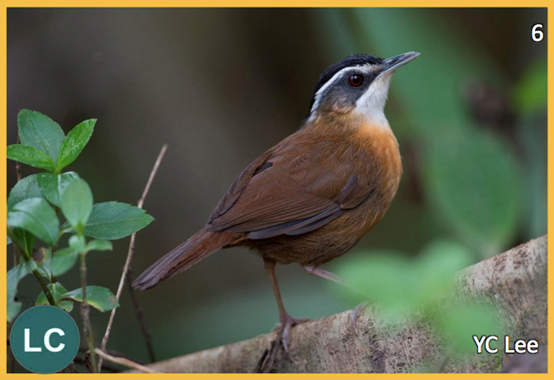Sabah’s 6 Endemic Bird Species

1. BLACK-CROWNED PITTA (Erythropitta ussheri)
These birds are typically 13–15.5 cm long and weigh around 50–64 g. Adult pittas have a clear black head and breast, standing out against a red belly. They also showcase noticeable pale blue stripes extending from their eyes and dark purple-blue upperparts with a shiny blue patch on the wing.
These birds are known for their distinctive calls which vary from soft whistles to loud penetrating screams depending on different phases of life including mating season. Although it is listed as Least Concern on the IUCN Red List, conservation efforts remain critical towards preserving this exotic bird for future generations.

2. BORNEAN BLACK-CAPPED BABBLER (Pellomeum capistratoides)
This robust and compact brown babbler displays a deep-hued crown, an orange chest, and a vivid white throat. In the subspecies found in North Borneo, a dark face and delicate white eyebrows set it apart from other variants.
The bird forages on the forest floor, resembling the movements of a rodent as it searches through fallen leaves. The Bornean Black-Capped Blabber is commonly sighted either as a solitary individual or in pairs. While the current population size remains unknown, this species is recognized for its preference for dwelling primarily in lowland and foothill forests.

3. KINABALU FRIENDLY WARBLER (Locustella accentor)
The Kinabalu Friendly Warbler thrives in the montane forests of high altitudes, sustaining itself primarily on an insect-based diet. This bird is identifiable by its unique dark brown plumage, complemented by a speckled gray throat and chest, and a distinctive long, broad tail.
While there remains a dearth of detailed information about this species, the Kinabalu Friendly Warbler is frequently sighted and photographed within the bounds of Kinabalu Park. Initially designated as “Least Concern” on the IUCN Red List in 2016, its status was later revised to “Threatened” during the years spanning from 2017 to 2020.

4. WHITE-CROWNED SHARMA (Copsychus stricklandii)
Measuring approximately 21–28 cm (8.3–11.0 in) in length and weighing between 31–42, the White Crowned Sharma showcases blue-black upperparts contrasting with orange-rufous underparts, along with a distinctive white rump and a black throat.
Based on studies, White-crowned Shamas are renowned for their melodious and captivating tunes, as well as their skill in imitating various bird calls and sounds (Collar, 2005; Roberts et al., 2020; Smythies, 1999). They are well known by the people of Sabah due to these attributes. However, ecological research on them has been limited, resulting in a scarcity of information regarding their natural behaviours and history.

5. SABAH PARTRIDGE (Tropicoperdix graydoni)
According to www.birdsoftheworld.org, the Sabah Partridge is a terrestrial species that is confined to the Malaysian state of Sabah (in northeast Borneo). The partridge has a brownish-gray plumage with black spots and white streaking on its underparts.
The Sabah Partridge, frequently captured in photographs and observed along the Kinabatangan River, faces a concerning decline in its population. As a result of this decline, it has been categorized as “Near Threatened” on the IUCN Red List.

6. WHITE-FRONTED FALCONET (Microhierax latifrons)
According to the Malaysia Biodiversity Information system, the White-Fronted Falconet, also known as the Bornean falconet, holds the title of being the world’s smallest falcon.
In terms of appearance, adult male Bornean falconets have a white forehead and crown, while the underparts are white with chestnut coloring on the belly and black markings on the wing coverts. Their upperparts are glossy blue-black, and they have brown eyes, black cere, and black feet. Females can be distinguished by a chestnut forehead and crown.
This species is restricted to northern Borneo, has a relatively small total population size, and its population trend is decreasing, putting the Bornean falconet on the IUCN Red List as Near Threatened.